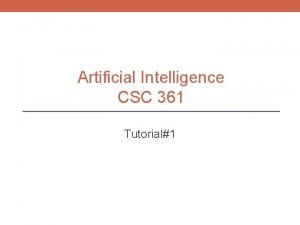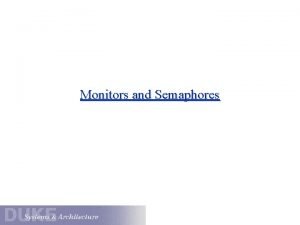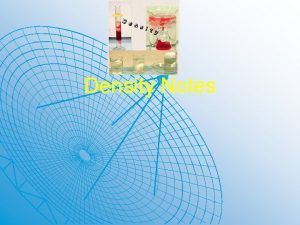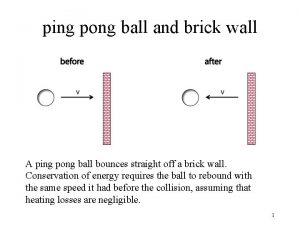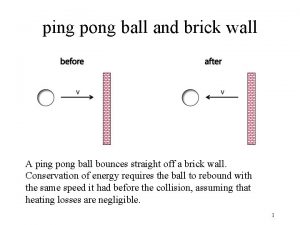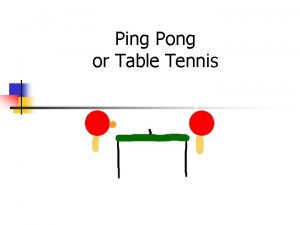Ping Pong Ping pong is the game we























- Slides: 23

Ping Pong

Ping pong is the game we play with our friends, maybe at tooker or Manzi or Barrett, we make our own rules for it. The difference between ping pong and table tennis is, table tennis is a sport with a specific set of rules played in a professional setting, it is also a sport in the Olympics.

Our video

(-31. 8, 61. 7) (0, 71) Sydney’s curve (100, 10) (-97, 0) g(x) = -. 0068 x^2 +. 071 x + 71 g’(x)=-. 0136 x^2 +. 071

Distance Nearest to the Origin For example we have two points of the coordinate plane (0, 0) and (3, 4). We can plug the values to get a distance of 5. We get the formula from the Pythagoras theorem

The length of the Arc length of a curve can be found if we make the curve into infinitely small line segments and find the distance of each of the curves. “Formula comes from approximating the curve by straight lines connecting successive points on the curve, using the Pythagorean Theorem to compute the lengths of these segments in terms of the change in xx and the change in yy. In one way of writing, which also provides a good heuristic for remembering the formula, if a small change in xx is dxdx and a small change in yy is dydy, then the length of the hypotenuse of the right triangle with base dxdx and altitude dydy is (by the Pythagorean theorem)” hypotenuse =(dx 2+dy 2)^(½)=(1+(dy/dx)^(2))^(½) Arc Length =

Vikas’s Curve Arc Length = 210. 886 cm Velocity = 4. 9 m/s (0, 44) (100, 20) (-95, 0) f(x) = -. 0036059379 x^2 +. 1205937922 x + 44 f’(x) = -. 0072118758 x +. 1205937922 f’’(x) = -. 0072118758

Surface Area of Ping-Pong Ball using Revolutions Description: “A surface of revolution is a three-dimensional surface with circular cross sections. For these problems, you divide the surface into narrow circular bands, figure the surface area of a representative band, and then just add up the areas of all the bands as they approaches infinity to get the total surface area. A surface generated by revolving a function, y = f (x), about an axis has a surface area — between a and b — given by the following integral”: Mathematical Representation:

Graphical Representation of Ping Pong Ball Surface Area “Plotted below is the function f(x)= (4 -x 2)(½) (the positive curve of the circular base of the ping pong ball being revolved around the line y=0). On the right is a visual representation of a cross-section created by a secant line attached to the curve. On the left is the same cross section, this time as the number of secant lines approaches infinity-- creating an infinite number of cross sections”.

1 st Degree Taylor Polynomial (aka: Linear Approximation) Description: A Taylor series is a way to approximate the value of a function by taking the sum of its derivatives at a given point. It is a series expansion around a point x=a known as the focal point. If x=0 then the series is called a Maclaurin series, a special case of the Taylor series. When using a 1 st degree Taylor polynomial to approximate a function it is also known as Linear Approximation. Mathematical Representation:

Linear Approximation of Vikas’s Curve @ x=-95 Equation of curve: f(x) = -. 0036059379 x^2 +. 1205937922 x + 44 1 st Derivative: f’(x) = -. 0072118758 x +. 1205937922 1 st Degree Taylor Polynomial (centered @ x=-95): 1. 935(10 -7) +. 8057219932(x+95)

Graphical Representation of Linear Approximation

Sandy’s curve (0, 55) (100, 20) (-100, 0) h(x)= -. 0045 x^2 +. 1 x + 55

In mathematics, a Riemann sum is an approximation that takes the form of a combination of rectangles. One very common application is approximating the area of functions or lines on a graph, but also the length of curves and other approximations. Now that we know the definition of a Riemann sums let's apply it to ping pong

Area of the curve by riemann sums




Area between the curves - There a few steps we need to follow to find the area between curves 1. Find the points where the curves intersect. 2. Make them your two end points in the integral 3. Subtract the lower arc from the upper one in the integral and integrate with the two end points

Area between Vikas’s and Sandy’s Curve

Here is the area between Sydney and Vikas’s curves

Works Cited http: //www. mathwarehouse. com/algebra/distance_formula/index. php http: //www-math. mit. edu/~djk/18_01/chapter 17/section 01. html http: //mathworld. wolfram. com/Riemann. Integral. html http: //www. mathopenref. com/arclength. html https: //prezi. com/1 oeit-s-25 nc/riemann-sum/ http: //www. dummies. com/education/math/calculus/how-to-find-the-area-of-a-surface-of-revolution/ http: //www. chegg. com/homework-help/definitions/taylor-series-29 https: //www. cliffsnotes. com/study-guides/calculus/applications-of-the-definite-integral/volumes-of-solids-with-known-crosssections

Thank you
 Examine the ai literature to discover whether the following
Examine the ai literature to discover whether the following How to make a ball game on scratch
How to make a ball game on scratch Fundamentos del ping pong
Fundamentos del ping pong Ping pong parachute launcher
Ping pong parachute launcher Ping pong
Ping pong Pravidla biliardu
Pravidla biliardu Ping pong uu
Ping pong uu Verbal communication: the way people speak
Verbal communication: the way people speak Als een potvis in een pispot pist
Als een potvis in een pispot pist Tennis rules youtube
Tennis rules youtube Monitors
Monitors Puisi mantra sutardji
Puisi mantra sutardji Table tennis regulations
Table tennis regulations What is the density of a golf ball
What is the density of a golf ball Sartrouville tennis de table
Sartrouville tennis de table Ping pong debate
Ping pong debate Fracture ping pong
Fracture ping pong Programtorget hb
Programtorget hb A very light ping pong ball moving east at a speed
A very light ping pong ball moving east at a speed How to curve a ping pong ball
How to curve a ping pong ball Ping pong ball funnel air pressure
Ping pong ball funnel air pressure Registr ping pong
Registr ping pong Erörterung sanduhr oder ping pong
Erörterung sanduhr oder ping pong Literal language?
Literal language?
